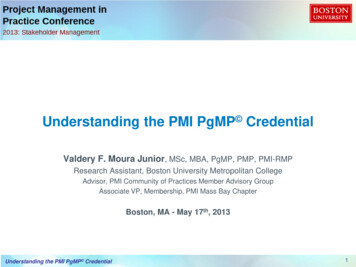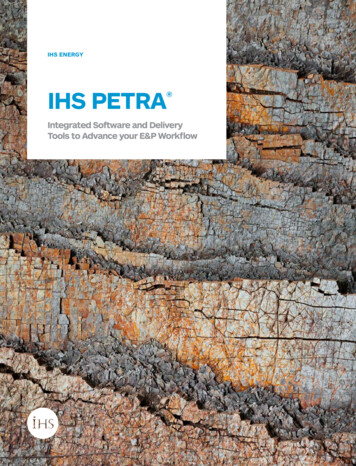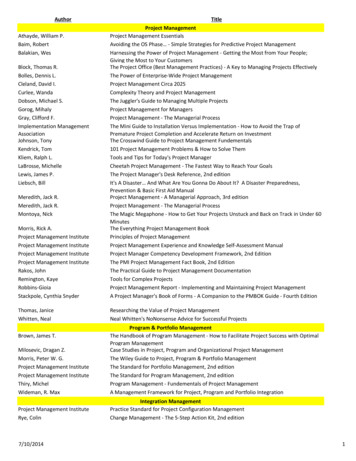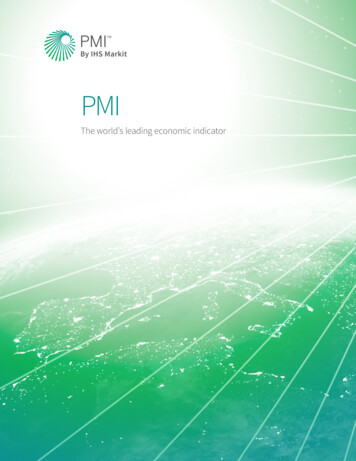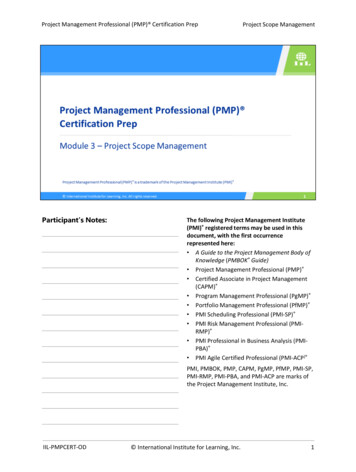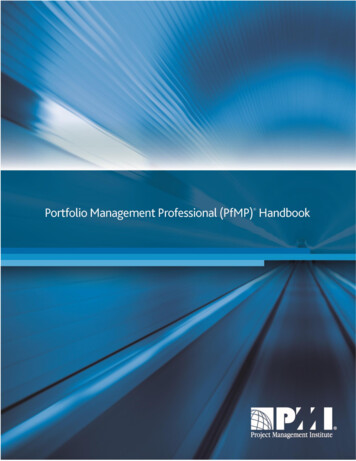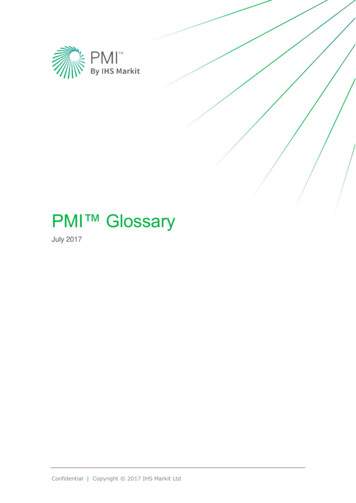
Transcription
PMI GlossaryJuly 2017Confidential Copyright 2017 IHS Markit Ltd
PMI GlossaryAACTIVITY (BUSINESS – CONSTRUCTION/SERVICES)ASEAN MANUFACTURING PMIThe ASEAN Manufacturing PMI (Purchasing Managers' Index) is produced by IHS Markit and isbased on original survey data collected from a representative panel of around 2100manufacturing firms. National data are included for Indonesia, Malaysia, Myanmar, thePhilippines, Singapore, Thailand and Vietnam. Taken together, these countries account for anestimated 98% of ASEAN manufacturing activity.ASIA SECTOR PMIThe Asia manufacturing, services and whole economy PMI survey data have been analysed atsector level, using IHS Markit sector definitions.Asia IHS Markit Sector PMI data coverageTier 2GroupsBasic MaterialsConsumer GoodsTier 3SectorsChemicalsResourcesForestry & Paper ProductsMetals & MiningAutomobiles & Auto PartsBeverages & FoodHousehold & Personal Use ProductsConsumer ServicesFinancialsBanksInsuranceReal EstateHealthcareHealthcare ServicesPharmaceuticals & BiotechnologyIndustrialsIndustrial GoodsIndustrial ServicesTechnologyTier 4Sub-sectorsMachinery & EquipmentConstruction MaterialsCommercial & Professional ServicesGeneral IndustrialsTransportationTechnology EquipmentSoftware & Services 2
PMI GlossaryAUSTRALIA MANUFACTURING PMIThe Commonwealth Bank Manufacturing PMI is based on data compiled from monthly replies toquestionnaires sent to a representative panel of purchasing executives in over 400 private sectormanufacturing firms in Australia. The panel is stratified by GDP and company workforce size.AUSTRALIA SERVICES PMIThe Commonwealth Bank Services PMI is based on data compiled from monthly replies toquestionnaires sent to a representative panel of purchasing executives in over 400 private sectorservices firms in Australia. The panel is stratified by GDP and company workforce size.AUSTRIA MANUFACTURING PMIThe Austrian Manufacturing PMI Report is based on data compiled from monthly replies toquestionnaires sent to purchasing executives in 300 industrial companies in Austria. The panel isstratified by GDP and company workforce size.BBACKLOGS (MANUFACTURING/SERVICES)BRAZIL MANUFACTURING PMIThe Brazil Manufacturing PMI Report is based on data compiled from monthly replies toquestionnaires sent to purchasing executives in around 350 manufacturing companies in Brazil.The panel is stratified by GDP and company workforce size.BRAZIL SERVICES PMIThe Brazil Services PMI Report uses a panel of around 350 regularly participating companies tomonitor trends in business conditions in the Brazilian private sector services economy. The panelhas been carefully selected to accurately replicate the true structure of the Brazilian serviceseconomy. 3
PMI GlossaryBROAD MANUFACTURING SECTORSAs well as producing overall manufacturing indices, IHS Markit is able to produce similar dataseries for three broad manufacturing sectors (consumer goods, intermediate goods andinvestment goods). The data are derived from the national manufacturing survey panels.The broad manufacturing sector data are currently available for France, Germany, Italy, Spainand the UK.BUSINESS EXPECTATIONS (CONSTRUCTION/SERVICES)CCAPACITY UTILISATION INDEX SERIESIHS Markit have derived an indicator of capacity utilisation from existing PMI data. This has beenachieved by using a weighted combination of the backlogs of work and suppliers’ delivery timesindices (inverted) from national surveys.Backlogs of work is a good indicator of capacity utilisation, as higher levels of unfinished workshould logically indicate that firms are struggling to cope with their current workloads and, assuch, are already working at or near to full capacity. The inverse should logically be the casewhen backlogs of work are falling.Delivery times, in turn, can be used as a useful gauge to the pressure being placed on suppliers’capacity. Although a number of different factors can affect average supplier lead-times, demandfor a company’s products would be the most consistently significant determinant of suppliers’capacity utilisation and in turn, their ability to meet agreed delivery schedules. Slower deliverytimes should typically point to high capacity utilisation rates at suppliers. Faster delivery timesshould typically signal the opposite.CAPACITY UTILISATION – AVAILABLE COUNTRIESIHS Markit has derived capacity utilisation series for the following 23 countries/economic regions: UK Germany France 4
PMI Glossary Italy Eurozone Spain Hong Kong Turkey Netherlands Greece Austria Czech Republic Poland Russia Ireland Japan China European Union Brazil Global India South Korea TaiwanCHINA MANUFACTURING PMIThe China Manufacturing PMI Report is based on data compiled from monthly replies toquestionnaires sent to purchasing executives in over 500 industrial companies in China. Thepanel is stratified geographically and by Standard Industrial Classification (SIC) group, based onthe regional and industry contribution to Chinese industrial production. 5
PMI GlossaryCHINA SERVICES PMIThe China Services PMI is based on data compiled from monthly replies to questionnaires sent topurchasing executives in over 400 private service sector companies. The panel has beencarefully selected to accurately replicate the true structure of the services economy.CONSTRUCTION INDICESIHS Markit’s national construction surveys use identical methodologies and collect questionbased data to produce the following diffusion indices: Construction PMI – Total Construction Activity Housing Activity Index Commercial Activity Index Civil Engineering Activity Index New Orders Index Employment Index Suppliers’ Delivery Times Index Quantity of Purchases Index Input Prices Index Sub-Contracting Indices Future Construction ActivityCONSTRUCTION PMIUnlike the Manufacturing PMI, the Construction PMI is not a weighted composite index. Rather, itis a seasonally adjusted index designed to measure total construction activity. The index isderived from the question that asks respondents to compare the level of total construction activitywith the situation one month ago.CONSTRUCTION QUESTIONNAIRESThe following questions are asked of respondents participating in the PMI construction surveys: 6
PMI GlossaryTotal Construction ActivityTotal construction activity compared with the situation one month ago, with respondents asked toprovide a breakdown for the following three types of activity: Housing Commercial Civil EngineeringSub-contractingRespondents are asked to compare the current situation for the following four variables with thesituation one month ago: Sub-contractor usage Quality of sub-contractors Availability of sub-contractors Rates charged by sub-contractorsNew OrdersThe level of new orders received (in units, not money) this month compared with the situation onemonth ago. Domestic and export orders are included in this definition.Quantity of PurchasesThe volume or number of items purchased this month compared with the situation one monthago.EmploymentThe level of full time employment this month compared with the situation one month ago. For thepurpose of calculation it is agreed that two part time employees should be treated as one full timeemployee. Seasonal hiring of employees is excluded in this definition. 7
PMI GlossaryInput PricesAverage prices of all goods purchased (volume weighted) this month compared with the situationone month ago.Suppliers’ Delivery TimesThe average length of time agreed to deliver the goods this month compared with the situationone month ago.Business ExpectationsWhether business activity levels will be higher, the same or lower than current levels in 12months’ time.CZECH REPUBLIC MANUFACTURING PMIThe Czech Republic Manufacturing PMI is based on data compiled from monthly replies toquestionnaires sent to purchasing executives in over 300 industrial companies in the CzechRepublic. The panel is by GDP and company workforce size.DDENMARK MANUFACTURING PMIThe Danish Manufacturing PMI is produced by DILF using a methodology identical to that usedby IHS Markit. For more information go to www.dilf.dkDEVELOPED MARKETS PMIDeveloped Markets PMI data are available at the Manufacturing, Services and Composite levels.The countries classed as Developed Markets are:Australia, Austria, Canada, France, Germany, Greece, Hong Kong, Ireland, Italy, Japan,Netherlands, Singapore, South Korea, Spain, Taiwan, United Kingdom, United States 8
PMI GlossaryDIFFUSION INDICESThe percentages of survey respondents reporting an increase, no change or decrease for eachsurvey variable are converted into a single-figure ‘diffusion index’ according to the followingformula:INDEX P1*1 P2*0.5 P3*0P1 Percentage number of answers that reported an improvement.P2 Percentage number of answers that reported no change.P3 Percentage number of answers that reported a deterioration.Thus, if 100% of the panel reported an improvement the index would be 100.0. If 100% reporteda deterioration the index would be zero. If 100% of the panel saw no change the index would be50.0 (P2 * 0.5).DUBAIThe Dubai Economy Tracker is based on the Purchasing Managers’ Index (PMI) series, and is aneconomic indicator compiled from monthly surveys of carefully selected companies in Dubai. Ittracks variables such as output, new orders, employment and prices across the economy as awhole, with sub-sector available for three key areas of the economy (travel & tourism,construction and wholesale & retail).EEGYPT WHOLE ECONOMY PMIThe Egypt PMI Report is a monthly publication, researched and published by IHS Markit,featuring original research data from a survey of around 450 private sector companies operatingin Egypt. The companies have been carefully selected to represent the true structure of theEgyptian economy, including manufacturing, services, construction and retail. The panel isstratified by Standard Industrial Classification (SIC) group, based on industry contribution to GDP.EMERGING MARKETS INDEX (EMI)Emerging Markets PMI data are available for manufacturing, services and composite. Thecountries classed as Emerging Markets are as follows:Brazil, China, Czech Republic, Egypt, India, Indonesia, Kenya, Lebanon, Malaysia, Mexico,Nigeria, Philippines, Poland, Russia, Saudi Arabia, South Africa, Thailand, Turkey, United ArabEmirates, VietnamEMPLOYMENT (CONSTRUCTION / MANUFACTURING / SERVICES) 9
PMI GlossaryEUROPE SECTOR DATAThe EU manufacturing, services and construction PMI survey data have been analysed at sectorlevel, using IHS Markit sector definitions.EUROPE IHS Markit Sector PMI data coverageTier 2GroupsBasic MaterialsConsumer GoodsTier 3SectorsChemicalsResourcesTier 4Sub-sectorsForestry & Paper ProductsMetals & MiningAutomobiles & Auto PartsBeverages & FoodFoodBeveragesHousehold & Personal Use ProductsConsumer Services MediaTourism & RecreationFinancialsBanksOther FinancialsReal EstateHealthcareHealthcare ServicesPharmaceuticals & BiotechnologyIndustrialsIndustrial GoodsMachinery & EquipmentConstruction MaterialsIndustrial ServicesCommercial & Professional ServicesConstruction & EngineeringGeneral IndustrialsTransportationTechnologyTechnology EquipmentSoftware & ServicesEUROPE PMI survey coverageAustriaCzech PolandSpainUnited KingdomManufacturing ServicesConstruction 10
PMI GlossaryPMI Question Coverage for SectorsManufacturingServices equivalentConstruction equivalentOutputBusiness ActivityTotal ActivityNew OrdersNew BusinessNew OrdersNew Export OrdersXXBacklogs of WorkOutstanding BusinessXEmploymentEmploymentEmploymentOutput PricesPrices ChargedXInput PricesInput PricesInput PricesSuppliers’ Delivery TimesXSuppliers' Delivery TimesStocks of Finished GoodsXXQuantity of PurchasesXQuantity of PurchasesStocks of PurchasesXXFuture OutputFuture ActivityFuture ActivityPMIXXEUROZONE COMPOSITE INDICESThe eurozone manufacturing and eurozone service sector data are weighted together to producethe overall eurozone composite indices.The weights are derived from the relative importance of the manufacturing and service sectors(for those sectors covered by the PMI surveys) across the eurozone as a whole, based on grossvalue added data from Eurostat.Seven Eurozone Composite indices are currently produced: Eurozone Composite Output Index 11
PMI Glossary Eurozone Composite New Orders Index Eurozone Composite Employment Index Eurozone Composite Input Prices Index Eurozone Composite Backlogs of Work Index Eurozone Composite Output Prices Index Eurozone Composite Future Output IndexAltogether, information is collected by questionnaire from around 4,500 manufacturing andservices companies each month.EUROZONE CONSTRUCTION PMIEurozone construction data are currently based on surveys in Germany, France, Italy and Ireland.EUROZONE MANUFACTURING INDICESA composite eurozone series for each of the eleven manufacturing indices are calculated bytaking a weighted average of the individual (seasonally adjusted) national manufacturing indicesin question. For example, the Eurozone Manufacturing Output Index is calculated as a weightedaverage of the Manufacturing Output indices of each of the eight eurozone nations covered.Weights are derived from the latest Eurostat data on the gross value added of manufacturing (ineuros) for each of the nations covered. Total manufacturing gross value added of the eightcountries is calculated and then each component country's manufacturing GVA is calculated as apercentage of the total of the eight countries, giving a weight for each country.In addition to the usual eleven indices, a composite manufacturing PMI for the eurozone isproduced by weighting together the eurozone manufacturing indices of output, new orders,employment, suppliers' delivery times and stocks of purchases, using the usual PMI weights.The eurozone surveys are conducted in Germany, France, Italy, Spain, Austria, Greece, theNetherlands and Ireland, accounting for 89% of total eurozone manufacturing output.EUROZONE RETAIL PMIFor the Retail PMI, IHS Markit has recruited a representative panel of retail companies in France,Germany and Italy. Together, these three countries account for approximately 62% of totaleurozone retail sales by value. The panel includes large chain retailers as well as smaller retailers 12
PMI Glossaryto ensure balanced representation of the true structure of the eurozone retail sector. Similarly, thecomposition of the panel by classification of retailer (i.e. type of good sold) is monitored to ensureaccurate representation. IHS Markit ensures the correct structure remains in place over time andthat response rates remain sufficiently high to generate reliable economic data.The Retail PMI surveys cover the following specific sectors. The definition of the retailers includedin each sector is shown along with the Standard Industrial Classification (SIC) codes of thecompanies included in each sector. Clothing & Footwear: Retail sale of clothing, footwear and leather goods (SIC 5242 & 5243) Food & Drink: Retail sale of food, beverages and tobacco (SIC 5210 & 5220) Household Goods: Retail sale of household goods (SIC 5240, 5241, 5244-5248) Autos & Fuel: Sale of motor vehicles and motorcycles; Retail sale of automotive fuel (SIC5000) Pharmaceuticals: Retail sale of pharmaceutical and medical goods, cosmetic and toiletries(SIC 5230) Other (included in total only): Other retail not in stores (SIC 5250 & 5260)EUROZONE SERVICES INDICESComposite eurozone series for each of the services indices are calculated by taking a weightedaverage of the individual (seasonally adjusted) national indices in question. For example, theEurozone Service Sector Business Activity Index is calculated as a weighted average of theService Sector Business Activity indices of each of the five eurozone nations covered.Weights are derived from the latest Eurostat data on gross value added of services (in euros) foreach of the nations covered. Total service sector gross value added of the five countries iscalculated and then each component country's services GVA is calculated as a percentage of thetotal of the five countries, giving a weight for each country.Surveys are conducted in Germany, Italy, France, Spain and Ireland, accounting for 78% of totaleurozone private sector services output.EXPORT CLIMATE PMIThe Export Climate PMIs are calculated by weighting together national PMI data on output trendsfrom PMI surveys for manufacturing, services and construction. All data are seasonally adjusted.Weights are derived from government statistics relating to the relative importance of individualtrading partners’ contributions to the external trade of a specific country (henceforth referred to as‘country A’). Our website currently carries Exporters’ PMI data for the United States of America,China, Japan, India, Germany, the United Kingdom, France, Italy, Brazil and Spain. 13
PMI GlossaryBy weighting together the output trends from national PMI surveys according to their importanceto the external trade of country A, an advance indicator for the economic health of country A’sexport markets is obtained.The output trends for country A’s trading partners are calculated using a weighted average of(where available) their Manufacturing PMI Output, Services PMI Business Activity andConstruction PMI Activity indices.The sector coverage of output trends for each country available for inclusion in the Exporters’ PMIseries are shown in the table sYesAustriaYesBrazilYesYesChinaYesYesCzech esGreeceYesYesHong esYesKenyaWholeEconomyYesYesYes 14
PMI therlandsYesNew c of IrelandYesYesRussiaYesYesYesSaudi ArabiaYesSingaporeYesSouth AfricaYesSouth TurkeyYesYesYesUnited Arab EmiratesUnited KingdomYesYesUnited States ofAmericaYesYesVietnamYesYes 15
PMI GlossaryN.B. As the Exporters’ PMI measures export performance, data for country A are excluded fromthe Exporters’ PMI composition. For example, the composition of the UK Exporters’ PMI does notinclude PMI data for the UK.FFLASH PMIThe Flash PMIs are advance estimates of final PMI data. The Flash PMI data are publishedapproximately one week before final PMI data and are typically based on 85%-90% of total PMIresponses each month.Flash PMI data are currently produced for the below surveys:EurozoneFranceGermanyUSJapanManufacturing Services CompositexxxxxxxxxxxxxFRANCE CONSTRUCTION PMIThe IHS Markit French Construction PMI survey uses a panel of regularly participating companiesto monitor trends in business conditions in the private sector construction economy. The panelhas been carefully selected to accurately replicate the true structure of the construction economy.FRANCE MANUFACTURING PMIThe French Manufacturing PMI Report features survey data collected from a representative panelof over 400 companies based in the French manufacturing sector. The panel is stratified by GDPand company workforce size.FRANCE SERVICES PMIThe French Services PMI Report features original survey data collected from a representativepanel of over 300 companies based in the French service sector. The panel has been carefullyselected to accurately replicate the true structure of the services economy. 16
PMI GlossaryFRANCE RETAIL PMIFor the France Retail PMI, IHS Markit has recruited a representative panel of retail companies.The panel includes large chain retailers as well as smaller retailers to ensure balancedrepresentation of the true structure of the French retail sector. Similarly, the composition of thepanel in geographical terms and by classification of retailer (i.e. type of good sold) is monitored toensure accurate representation.GGERMANY CONSTRUCTION PMIThe IHS Markit German Construction PMI survey uses a representative panel of over 200companies based in the German construction sector. The panel structure is designed toaccurately represent the structure of the German economy, taking into account the different subsector weights by CNAE-93 (National Classification of Economic Activities) group, based on theregional, company size and industry contribution to GDP.GERMANY MANUFACTURING PMIThe German Manufacturing PMI features original survey data collected from a representativepanel of over 500 companies based in the German manufacturing sector. The panel is stratifiedby GDP and company workforce size.GERMANY RETAIL PMIFor the Germany Retail PMI, IHS Markit has recruited a representative panel of retail companies.The panel includes large chain retailers as well as smaller retailers to ensure balancedrepresentation of the true structure of the German retail sector. Similarly, the composition of thepanel in geographical terms and by classification of retailer (i.e. type of good sold) is monitored toensure accurate representation.GERMANY SERVICES PMIThe German Services PMI Report features original survey data collected from a representativepanel of over 500 companies based in the German service sector. The panel has been carefullyselected to accurately replicate the true structure of the services economy.GLOBAL COMPOSITE INDICESGlobal manufacturing and service sector data are weighted together to produce the overall GlobalComposite Indices. The weights are derived from the relative importance of the manufacturing 17
PMI Glossaryand service sectors (for those service sectors covered by the PMI surveys) across all thosecountries covered by the Global PMI surveys, based on gross value added data from the WorldBank.Six Global Composite indices are produced: Global Composite Output Index Global Composite New Orders Index Global Composite Employment Index Global Composite Input Prices Index Global Composite Output Charges Global Composite BacklogsGLOBAL ELECTRONICS PMIThe Global Electronics data are compiled from monthly replies to questionnaires sent topurchasing executives in over 600 companies that specialise in the manufacture of goods whichutilize semiconductors and ICs as key inputs in the production process.The sectors covered by the survey include: Manufacture of computers and other information processing equipment; Wired and wireless communications devices; Manufacture of medical, precision and optical instruments; Manufacture of consumer electronics devices.Companies participating in the survey include firms based in the US, Western and Central Europeand Asia (including Japan, China, Hong Kong, Taiwan and South Korea).In line with IHS Markit manufacturing PMIs, the Global Electronics PMI is a weighted compositeindex derived from the usual five individual indices. 18
PMI GlossaryGLOBAL MANUFACTURING INDICESResults from the national manufacturing surveys are used in the compilation of the Globalmanufacturing series to produce the following eight indices: Manufacturing Output Index Manufacturing New Orders Index Manufacturing New Export Orders Index Manufacturing Input Prices Index Manufacturing Suppliers' Delivery Times Index Manufacturing Stocks of Purchases Index Manufacturing Employment Index Manufacturing Future OutputComposite Global series for each of these indices are calculated by taking a weighted average ofthe individual (seasonally adjusted) national manufacturing indices in question. For example, theGlobal Manufacturing Output Index is calculated as a weighted average of the ManufacturingOutput indices in over 40 nations covered.In addition to the seven indices indicated above, a composite Global Manufacturing PMI isproduced by weighting together the Global manufacturing indices of output, new orders,employment, suppliers' delivery times and stocks of purchases, using the usual PMI weights.The surveys are conducted in the USA, Japan, the UK, Germany, France, Italy, Spain, theNetherlands, Austria, Ireland, Greece, Poland, the Czech Republic, Russia, China, India, Brazil,Turkey, South Korea, Taiwan, Indonesia, Mexico, Malaysia, Myanmar, the Philippines, Thailand,South Africa, Australia, Singapore, Kenya, Nigeria, UAE, Saudi Arabia, Egypt, Lebanon andVietnam by IHS Markit Economics and in a number of other countries: Denmark, Israel, Hungary,Switzerland and New Zealand. These countries together account for an estimated 95% of globalmanufacturing output.GLOBAL PMI SERIESThe Global PMIs, produced by IHS Markit, are designed to provide the most up-to-date picture ofglobal private sector business conditions.In total, the surveys cover an estimated 89% of global GDP. 19
PMI GlossaryGLOBAL SECTOR DATAThe Global manufacturing, services, construction and whole economy PMI survey data havebeen analysed at sector level, using IHS Markit sector definitions.Global IHS Markit Sector PMI data coverageTier 2GroupsBasic MaterialsConsumer GoodsConsumer ier 3SectorsChemicalsResourcesAutomobiles & Auto PartsBeverages & FoodTier 4Sub-sectorsForestry & Paper ProductsMetals & MiningFoodBeveragesHousehold & Personal Use ProductsMediaTourism & RecreationBanksInsuranceOther FinancialsReal EstateHealthcare ServicesPharmaceuticals & BiotechnologyIndustrial GoodsMachinery & EquipmentConstruction MaterialsIndustrial ServicesCommercial & Professional ServicesConstruction & EngineeringGeneral IndustrialsTransportationTechnology EquipmentSoftware & ServicesTelecommunication Services 20
PMI GlossaryGlobal PMI survey hinaCzech RepublicFranceEgyptGermanyGreeceHong esRussiaSaudi ArabiaSingaporeSpainSouth AfricaSouth holeeconomyXXXXXXXXXXXXXXXXXXXXXXXXXXXXXXXXXXXXXXX 21
PMI GlossaryPMI Question CoverageGLOBAL SERVICES INDICESResults from national service sector surveys are used in the compilation of the Global servicesseries to produce the following seven comparable indices: Service Sector Business Activity Index Service Sector New Business Index Service Sector Outstanding Business Index Service Sector Input Prices Index Service Sector Output Charges Service Sector Employment Index Service Sector Future Activity 22
PMI GlossaryComposite Global series for each of these indices are calculated by taking a weighted average ofthe individual (seasonally adjusted) national service indices in question. For example, the GlobalService Sector Business Activity Index is calculated as a weighted average of the Service SectorBusiness Activity indices of each of the 15 nations covered.Surveys are conducted in the USA, Japan, China, Germany, the UK, France, Italy, India, Brazil,Spain, Ireland, Russia, Hong Kong, Kenya, Nigeria, UAE, Saudi Arabia, South Africa, Singapore,Egypt and Lebanon by IHS Markit, and in New Zealand by Business NZ. These countriestogether account for an estimated 76% of global service sector gross value added (GVA).GLOBAL WEIGHTSWeights for the Global Indices are derived from the latest available World Bank data on the grossvalue added of manufacturing and services for each of the nations covered. World Bank data onvalue added are in constant 2000 US , with all national currencies converted to 2000 US by theWorld Bank using DEC alternative conversion factors.The DEC alternative conversion factor is the underlying annual exchange rate used for the WorldBank Atlas method. As a rule, it is the official exchange rate reported in the IMF's InternationalFinancial Statistics (line rf). Exceptions arise where further refinements are made by World Bankstaff.GREECE MANUFACTURING PMIThe Greek Manufacturing PMI Report is based on data compiled from monthly replies toquestionnaires sent to purchasing executives in 300 manufacturing companies in Greece. Thepanel is stratified by GDP and company workforce size.HHONG KONG WHOLE ECONOMY PMIThe Hong Kong PMI Report is a monthly publication, researched and published by IHS Markit,featuring original research data from a survey of purchasing managers in companies operating inHong Kong. The survey panel comprises over 300 companies. The panel is stratified by StandardIndustrial Classification (SIC) group, based on industry contribution to GDP.I 23
PMI GlossaryINDIA MANUFACTURING PMIThe India Manufacturing PMI Report is based on data compiled from monthly replies toquestionnaires sent to purchasing executives in over 400 manufacturing companies. The panel isstratified by GDP and company workforce size.INDIA SERVICES PMIThe India Services PMI is based on data compiled from monthly replies to questionnaires sent topurchasing executives in around 350 private service sector companies. The panel has beencarefully selected to accurately replicate the true structure of the services economy.INDONESIA MANUFACTURING PMIThe Indonesia Manufacturing PMI Report is based on data compiled from monthly replies toquestionnaires sent to purchasing executives in over 300 manufacturing companies. The panel isstratified by Standard Industrial Classification (SIC) group and company size, based on industrycontribution to Indonesian manufacturing value added.INPUT PRICES (CONSTRUCTION/MANUFACTURING/SERVICES)IRELAND CONSTRUCTION PMIThe Irish Construction PMI survey uses a panel of regularly participating companies to monitortrends in business conditions in the Irish private sector construction economy. The panel hasbeen carefully selected to accurately replicate the true structure of the construction economy.IRELAND MANUFACTURING PMIThe Irish Manufacturing PMI Report is based on data compiled from monthly replies toquestionnaires sent to purchasing executives in around 285 manufacturing companies. The panelis stratified by Sta
PMI Glossary 3 AUSTRALIA MANUFACTURING PMI The Commonwealth Bank Manufacturing PMI is based on data compiled from monthly replies to questionnaires sent to a representative panel of purchasing executives in over 400 private sector manufacturing firms in Australia. The panel is stratified by GDP and company workforce size. AUSTRALIA SERVICES PMI
